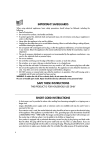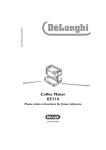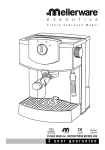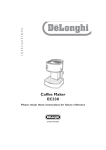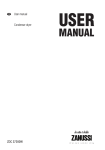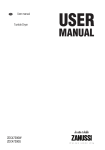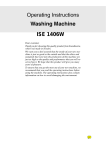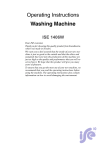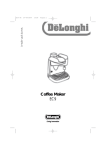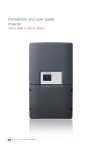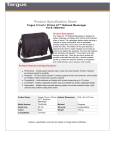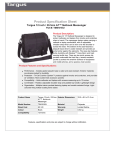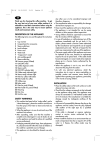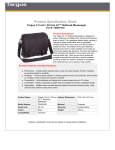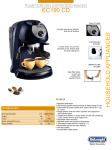Download De'Longhi EC190 User's Manual
Transcript
instructions Coffee Maker EC190 Please retain these instructions for future reference 2-cup filter 1-cup filter Filter holder Steam release knob Lid for water tank Water tank Steam nozzle Coffee tamper Milk frother Removable drip tray black area inside for positioning cups Boiler outlet Boiler "ON" function Coffee measuring spoon "O" OFF position OK/Ready light (coffee/water or steam) Steam function (for milk frothing) Espresso function Selector dial Coffee Maker 2 Thank you for choosing this coffee machine. To get the very best out of your new coffee machine it is advisable to read these instructions before using the appliance. This is the only way to ensure optimum results and maximum safety. Using for the first time Before using the machine for the first time, wash all the accessories in warm soapy water and rinse. For the best tasting coffee the internal circuits must be flushed through at least five times.To do this follow the instructions in the paragraph “How to prepare espresso coffee” using just water. Installation • Place the coffee maker on flat work surface at a safe distance from taps and sinks. • Check that the voltage corresponds to that indicated on the appliance rating plate.The appliance must always be connected to a well-earthed socket rated at 10A minimum.The manufacturer is not liable for damage caused by inadequate earthing of the appliance. • In the event of incompatibility between the plug on the appliance and the socket, have the plug replaced by a qualified professional. If the cable is damaged or requires replacing, contact a service centre authorised by the manufacturer only. • Never install the machine in an environment that can reach a temperature less than or equal to 0°C (if the water in it freezes, the coffee maker may be damaged). • When the machine is in operation, any additional cable can be stored in the machine by inserting it back into the cable supply outlet. • The power cable can be positioned to the right or left, depending on where the nearest power outlet to the appliance is located, by lodging it in the corresponding guides underneath the appliance (Fig. 1). • When changing the position of the power cable, check that it is properly secured by the special clips underneath the appliance (Fig. 1) fig. 1 3 Coffee Maker How to prepare espresso coffee Filling the water tank To remove the water tank lift the lid (fig.2) and simply pull upwards (fig 3) and fill the tank at the sink (fig 4). Do not exceed the MAX level on the water tank. The tank may also be filled without removing it, simply by pouring water into it directly from a jug. Replace the tank by connecting the valve at the bottom of the tank with the hole in the base on the machine. WARNING: it is completely normal for there to be water in the compartment under the tank; as a result, this compartment should be dried using a clean sponge. Note: Do not operate the appliance without water in the tank and always remember to fill the tank when the level drops to a couple of centimetres from the bottom. fig. 2 Preheating the coffee machine To ensure your espresso coffee is dispensed at the right temperature it is essential that the coffee unit is preheated. 1. Turn the selector knob so that the indented line on the selector points to the boiler “ON” function (fig. 5). Red light next to will come on. 2. Attach the empty filter holder (without coffee) to the machine by positioning it under the boiler outlet with the handle towards the left (fig 6). Push upwards and at the same time turn the handle as far right as possible. It does not matter if the handle is not centrally aligned with the machine, as long as the filter holder is firmly attached to the appliance. 3. Position a cup under the filter holder. Use the same cup that the coffee will be served in, so that it may be preheated. 4. Wait until the “OK” light comes on (fig 7) and turn the selector knob to the espresso function position (fig 8). Allow water to flow until the “OK” light goes out, then stop the flow of water by turning the selector knob to the boiler “ON” function (fig 5) 5. Empty the cup, wait until the “OK” pilot light comes on again and repeat the whole operation one more time. (It is normal for a small and harmless puff of steam to be given off when removing the filter holder). fig. 3 MAX fig. 4 fig. 5 1 2 fig. 6 fig. 7 Coffee Maker fig. 8 4 How to prepare espresso coffee 1. After carrying out the preheating of the machine as described in the preceding section, in order to make just one cup of espresso coffee, insert the 1-cup filter (the smaller of the two provided) into the filter holder (Fig. 9) and fill it with one level measuring spoon of ground coffee (fig. 10) – about 7 grams. If you wish to prepare two cups of espresso coffee, use the 2-cup filter (the larger of the two provided) and fill it with two lessthan-level measuring spoons of ground coffee (about 6+6 grams). IMPORTANT: for correct operation, before adding the ground coffee to the filter holder, make sure the filter is free from ground coffee from the previous infusion. 2. Distribute the ground coffee evenly and press it lightly with the coffee tamper (Fig. 11). NOTE:Pressing the coffee is very important in order to prepare a good coffee. However if you press too hard, coffee will come out slowly and crema will be of a dark colour. If you press to light, coffee will come out too fast and crema will be a very light colour. 3. Remove any excess coffee from the rim of the filter holder. Attach the filter holder to the machine by positioning the handle to the left of the boiler outlet, then pushing upwards and turning the handle to the right (as in preheating the machine fig. 6). 4. Place the cup or cups (cups can be preheated by rinsing under hot water) on the removable drip tray (fig 12). Ensure that the cup or cups line up with the dispensing holes on the filter holder.Turn the selector dial to boiler “ON” function (fig. 5). 5. Wait until the “OK” light comes on (fig 7) then turn the selector to the espresso function (fig 8). Allow water to flow until the “OK” light goes out, then stop the flow of water by turning the selector to the boiler “ON” function (fig. 5).Your espresso is now ready. 6. To detach the filter holder, turn the handle from right to left. To avoid any splashing, do not detach the filter holder while the machine is dispensing coffee. 7. To remove the used coffee lock the filter with the built-in lever and let the coffee fall out by knocking the over turned filter holder (fig. 13). 8. To switch off the coffee machine, turn the selector the OFF position “O” (fig 14) fig. 9 fig. 10 fig. 11 fig. 12 10 fig. 13 5 Coffee Maker How to make cappuccino 1. Prepare espresso coffee, using cups that are large enough for cappuccinos 2. Turn the selector knob to the position (fig. 15) and wait until the “OK” light comes on (fig. 7) to indicate that the boiler has reached the ideal temperature for producing steam. 3. Meanwhile, fill a heat resistant container/jug with approximately 3fl. oz. of milk for each cappuccino.The milk should be cooled from the refrigerator and semi-skimmed as this gives the best results. In choosing the container, bear in mind that the volume of the milk will increase by 2 or 3 times.The ideal container to use is a stainless steel jug. 4. Position the container with the milk in it under the milk frother (fig 16). 5. Immerse the steam nozzle about 5 mm deep into the milk and turn the steam release knob in an anti-clockwise direction (fig. 17) (by turning the knob to a greater or lesser extent, it is possible to vary the quantity of steam that comes out from the nilk frother). At this point, the milk will begin to increase in volume and to appear frothy. 6. When the volume of milk has doubled, immerse the steam nozzle and continue heating the milk. Once the desired temperature has been reached (the ideal temperature is 60°C or when the stainless steel jub is too hot to touch comfortably), stop the steam by turning the steam release knob in a clockwise direction and at the same time positioning the selector to the “O” off position (fig. 14). 7. Pour the frothed milk into the cups containing the espresso coffee.Your cappuccino is now ready. Add sugar to taste and, if desired, sprinkle a little powdered chocolate or cinnamon on top of the froth. Note: to prepare more than one cappuccino, first make all the coffees then at the end prepare the frothed milk for all the cappuccinos. IMPORTANT: always clean the milk frother and steam nozzle immediately after use. Proceed as follows: 1. Discharge a little steam for a few seconds by rotating the steam knob (fig. 17). 2. Wait several minutes for the steam tube to cool down. Unscrew the milk frother by rotating clockwise (fig. 18) and wash thoroughly with warm water. 3. Make sure the three holes in the milk frother shown in fig. 19 are not blocked. If necessary, clean with a pin. 4. Clean the steam tube, taking care to avoid burns. 5. Screw the milk frother back in place. fig. 14 fig. 15 fig. 16 fig. 17 fig. 18 Coffee Maker 6 Producing hot water 1. Turn on the coffee unit by turning the selector knob to the boiler “ON” position (fig. 5). 2. Position a container under steam nozzle. 3. When the ‘OK’ light comes on, position the selector at (fig. 7) and at the same time turn the steam knob in an anticlockwise direction (fig. 17); hot water will come out from the steam nozzle. 4. To stop the flow of hot water, turn the steam knob in a clockwise direction and position the selector knob at boiler “O” position (fig. 14). fig. 19 Cleaning and maintenance Cleaning the filter holder About every 300 coffees or when the coffee drips out of the filter holder or not at all, clean the ground coffee filter holder as follows: • Remove the filter from the filter holder. • Rinse all components and clean the metal filter thoroughly in hot water using a brush (fig. 20). Make sure the holes in the metal filter are not blocked. If necessary, clean with a pin (see fig. 21). Failure to clean as described above invalidates the guarantee. fig. 20 Cleaning the espresso boiler outlet At least twice a year, the espresso boiler outlet must be cleaned as follows: • Check that the coffee machine is not warm and the plug is removed from the mains. • Using a screwdriver, unscrew the screw that holds the outlet of the espresso boiler (fig. 22). • Clean the boiler with a damp cloth (fig. 23). • Clean the outlet thoroughly in hot water using a brush. Make sure the holes are not blocked. If necessary, clean with a pin. • Rinse the outlet under the tap, still scrubbing it. • Replace the outlet of the espresso boiler ensuring the screw is replaced firmly. Failure to clean as described above invalidates the guarantee. fig. 21 fig. 22 Other cleaning operations 1. Do not use solvents or detergents when cleaning the coffee maker. Use a soft, damp cloth. 2. Remove the drip-trays, empty them and wash them periodically ATTENTION: during cleaning, never immerse the unit in water – it is an electrical appliance. 7 fig. 23 Coffee Maker Descaling It is advisable to clean the calcium from the machine every 200 cups of coffee. It is recommended that specific (store-bought) products for descaling of espresso coffee machines be used. If such products are not available, it is possible to proceed as follows: 1. Fill the tank with water using 1 litre of water; 2. Dissolve 2 spoonfuls (about 30 grams) of citric acid in the water (available from chemists); 3. Turn the selector knob to the position and wait until the ‘OK’ light comes on. 4. Check that the filter holder is not attached and place a container under the outlet of the machine; 5. Turn the selector knob to the position and allow half of the solution in the tank to flow out.Then stop the flow by turning the selector to the “O” position (fig. 14). 6. Allow the solution to act for about 15 minutes, then start up the flow again until the tank is completely empty; 7. To eliminate the remains of the solution and the calcium, rinse the tank well, fill it with clean water and replace. 8. Turn the selector knob to the position and allow all of the remaining solution in the tank to flow out (fig. 8). 9. Turn the selector knob to the position (fig.5) and repeat operations 7 and 8 one more time. Repairs for malfunctioning caused by problems of calcium build-up are not covered by the guarantee if the descaling process described above is not carried out regularly. Coffee Maker 8 Problem solving PROBLEM POSSIBLE CAUSES SOLUTION • • Lack of water in the tank. The holes in the filter holder are blocked. The outlet of the espresso boiler is blocked. • • • The tank is badly inserted and the valve at the bottom is not open. • • The filter holder is badly inserted. • • The gasket of the espresso boiler has lost elasticity. The holes in the filter holder are blocked. • The ‘OK’ pilot light was not on when the coffee delivery switch was pressed. The preheating was not carried out. • Wait until the OK pilot light comes on. • • The cups were not preheated. • Carry out the preheating as indicated in the “Preheating the coffee unit” section. Preheat the cups by rinsing them in hot water. The pump is too noisy. • • The water tank is empty. The tank is inserted wrongly and the valve at the bottom is not open. • • Fill the water tank Press the tank lightly to open the valve at the bottom. The coffee crema is lightcoloured (the coffee comes out quickly from the spout). • The ground coffee has not been pressed enough. The quantity of ground coffee is scarce. The coffee is not ground finely enough. • Tamper the ground coffee down more. Increase the quantity of coffee. Only use coffee specifically ground for espresso coffee machines. Espresso coffee no longer comes out. • Espresso coffee drips from the edges of the filter holder, instead of from its holes. • The espresso coffee is cold. • • • • 9 • • • • Fill the water tank. Clean the holes in the spouts. Clean as indicated in the “Cleaning the espresso boiler outlet” section. Press the tank lightly so as to open the valve at the bottom. Attach the filter holder correctly by rotating firmly as far as it will go. Have the espresso boiler gasket replaced at an Service Centre Clean the holes in the filter holder. Coffee Maker PROBLEM POSSIBLE CAUSES SOLUTION • The ground coffee is too tightly pressed. The quantity of ground coffee is too much. The espresso boiler outlet is blocked. • Press the coffee less. • • The coffee is too finely ground. • Decrease the quantity of ground coffee. Clean the outlet as described in “Cleaning the espresso boiler outlet” section. Only use coffee specifically ground for espresso coffee machines. The coffee has an acidic taste. • The unit was not sufficiently rinsed after the descaling process procedure. • Rinse the unit as described in the “descaling” section. The milk does not froth when making a cappuccino. • The milk is not cold enough. • • The cappuccino maker is dirty. • Always use milk at refrigerator temperature. Carefully clean the pinholes in the milk frother The coffee crema is dark (the coffee comes out slowly from the spout). • • Coffee Maker 10 • Safety Warnings • This machine has been built to make coffee and to reheat beverages; please be careful to avoid burns from the sprays of hot water or steam and avoid any improper use. • When the appliance is in use, do not touch any of the machine’s hot surfaces. • After unpacking, make sure that the machine is complete and undamaged. In case of doubt, do not use the appliance and seek the advice of a qualified service professional. • Packaging materials (plastic bags, foam polystyrene, etc.) should not be left within the reach of children as this could be a potential source of danger. • This appliance is to be utilised for domestic use only. Any other use is to be considered improper and therefore, dangerous. • The manufacturer takes no responsibility for damage derived from improper use. • Never touch the appliance with wet or damp hands. • Never allow the appliance to be used by children or unfit persons. • Do not allow children to play with the appliance. • In case of breakdown or malfunctioning, turn the appliance off immediately and do not touch. For repairs, please contact a Service Centre authorized by the manufacturer and request the use of original replacement parts only. The lack of respect for this point may compromise the safe use of the appliance. • The power cable must never be replaced by the user. If the cable should become damaged, or needs to be replaced, please contact a Service Centre authorized by the manufacturer. • When the appliance is not in use, turn off and disconnect the plug from the socket. • As with any electrical appliance, whilst the instructions aim to cover as many eventualities as possible, caution and common sense should be applied when operating your appliance, particularly in the vicinity of young children. 11 Coffee Maker Green and Yellow to Earth 13 amp Fuse Brown to Live Blue to Neutral Cord Clamp Electrical requirements Before using this appliance ensure that the voltage indicated on the product corresponds with the main voltage in your home, if you are in any doubt about your supply contact your local electricity company. The flexible mains lead is supplied connected to a B.S. 1363 fused plug having a fuse of 13 amp capacity. Should this plug not fit the socket outlets in your home, it should be cut off and replaced with a suitable plug, following the procedure outlined below. Note: Such a plug cannot be used for any other appliance and should therefore be properly disposed of and not left where children might find it and plug it into a supply socket - with the obvious consequent danger. N.B. We recommend the use of good quality plugs and wall sockets that can be switched off when the machine is not in use. important: the wires in the mains lead fitted to this appliance are coloured in accordance with the following code: GREEN ANDYELLOW EARTH BLUE NEUTRAL BROWN LIVE As the colours of the wires in the mains lead of this appliance may not correspond with the coloured markings identifying the terminals in your plug, proceed as follows: The wire which is coloured green and yellow must be connected to the terminal in the plug which is marked with the letter E or by the earth symbol or coloured green or green and yellow. The wire which is coloured blue must be connected to the terminal which is marked with the letter N or coloured black. The wire which is coloured brown must be connected to the terminal which is marked with the letter L or coloured red. When wiring the plug, ensure that all strands of wire are securely retained in each terminal. Do not forget to tighten the mains lead clamp on the plug. If your electricity supply point has only two pin socket outlets, or if you are in doubt, consult a qualified electrician. Should the mains lead ever require replacement, it is essential that this operation be carried out by a qualified electrician and should only be replaced with a flexible cord of the same size. After replacement of a fuse in the plug, the fuse cover must be refitted. If the fuse cover is lost, the plug must not be used until a replacement cover is obtained. The colour of the correct replacement fuse cover is that of the coloured insert in the base of the fuse recess or elsewhere on the plug. Always state this colour when ordering a replacement fuse cover. Only 13amp replacement fuses which are asta approved to B.S. 1362 should be fitted. This appliance conforms to the Norms EN 55014 regarding the suppression of radio interference. Warning - this appliance must be earthed Coffee Maker 12













